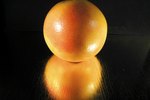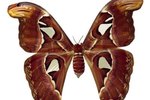
Silk has long been prized as a luxury fabric the world over for thousands of years. Few people understand it's a labor-intensive effort for many silkworms to produce a yard of fabric. The silkworm makes a strand of silk by secreting a protein from two salivary glands in his head.
Three Stages to Grow
The silkworm has three growth stages: larva, pupa and adult. He begins life as a larva after hatching from a tiny black egg. The larva spends four to six weeks feeding on mulberry leaves until he grows to about 3 inches. During this time, he'll molt his skin multiple times, shedding old skin in favor of roomier skin. After he's reached his target length, the caterpillar pupates, taking about three days to spin a silk cocoon, which covers the hard-shell brown pupa. It takes about three weeks for an adult moth to emerge from his cocoon. His time is short; he usually dies about five days after his transition. Before he does, he'll mate to allow the cycle to begin again.
Changing Appearances
The female moth will lay between 200 and 500 eggs, that change from lemon-yellow color to black before hatching in about 10 days. The larva is a creamy white caterpillar with three distinct parts: a head, thorax and abdomen. He has eight pairs of legs, including three pairs tipped with a single claw. Since the silkworm doesn't have lungs, he breathes through small holes in the side of his body. The moth emerging from his cocoon can't fly, despite his four white wings.
Life in Captivity
Along with the bee, the silkworm is the only other insect domesticated by man. He doesn't exist in the wild any longer, but if he did, he'd feed exclusively on the mulberry tree. If a cultivated silkworm doesn't have mulberry leaves to feed on, he's fed a diet formulated for his needs. Most cocoons in captivity don't transition into the moth stage because their work is complete after spinning their silk. After about a week in the cocoon state, most pupae are unwound to produce silk. A limited number of moths are allowed to emerge, mate and produce eggs to ensure the production continues.
From the Silk Road and Beyond
The Silk Road, the famous route for transporting silk between China and Rome, was built on the silkworm's ability to spin the fine fabric. In A.D. 6, two monks smuggled silkworm eggs out of China, giving other cultures the means to make the cloth. Currently, Japan, France, Spain and Italy join China in making silk. One silkworm's cocoon is made of a single thread, ranging from 900 to 3,000 feet long; 3,000 cocoons can produce 1 pound of silk.
References
Photo Credits
-
Photos.com/Photos.com/Getty Images




